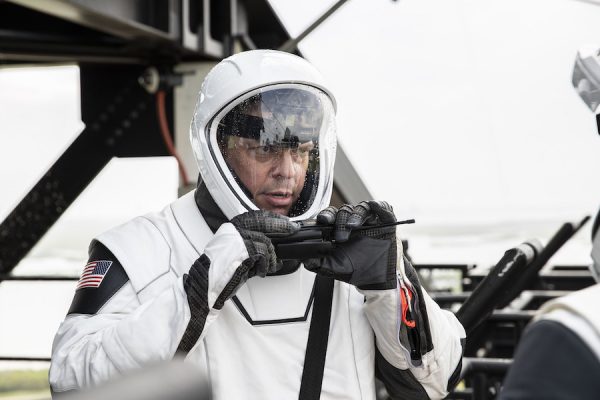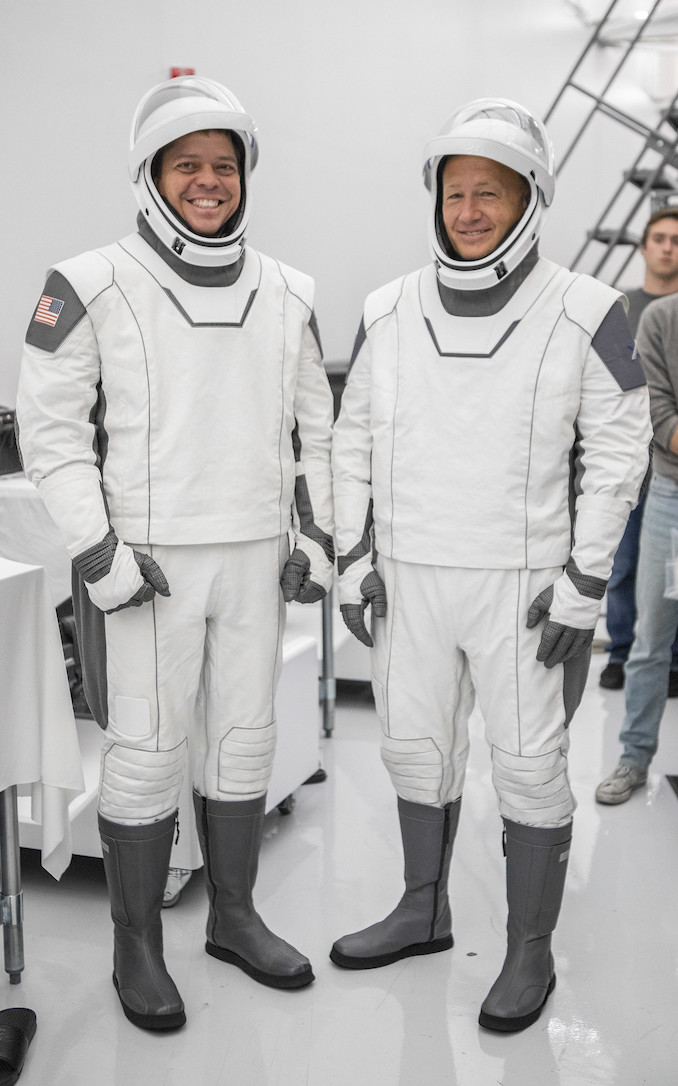NASA may ask SpaceX to extend duration of Crew Dragon test flight – Spaceflight Now

NASA astronauts Bob Behnken and Doug Hurley may spend more time on the International Space Station than originally planned when they ride SpaceX’s new human-rated Dragon spacecraft into orbit on its first crewed test flight, a space agency official said Friday.
A decision to extend the duration of the Crew Dragon test flight with Behnken and Hurley, designated Demo-2, is one of several options under consideration to ensure the space station remains staffed with U.S. astronauts after NASA’s agreement to procure seats on Russia’s Soyuz spacecraft expires next year.
In an interview with CNN last week, NASA Administrator Jim Bridenstine said the agency is also looking at purchasing more Soyuz seats from Roscosmos, the Russian space agency.
The final round-trip Soyuz seat procured by NASA will launch in March 2020 on the Soyuz MS-16 spacecraft, a mission also designated Soyuz 62S in the space station’s sequence of visiting vehicles. The crew member flying in that seat has not been announced, but a U.S. astronaut and a Japanese astronaut have been training to potentially fly on a Soyuz mission in early 2020.
NASA arranges crew transportation to and from the space station for U.S. astronauts and crew members from the European Space Agency, the Canadian Space Agency, and the Japan Aerospace Exploration Agency.
“Our last seat — Soyuz seat — we have on contract that we have an agreement with Roscosmos is, in fact, 62S, said Kirk Shireman, NASA’s space station program manager, in a press conference Friday. “It launches in March of next year, and probably will return in the October timeframe, roughly a year from now. That’s the last one we have on contract.”
Launch dates for new commercial crew ships in development by Boeing and SpaceX have been under review for months, and NASA has not published new target launch schedules since April, despite a previous announcement that such updates would be published “approximately monthly.”
There remains much uncertainty about when the new spacecraft will be ready to ferry crews to and from the space station. That led NASA to approve the first crewed test flight of Boeing’s Starliner capsule for a stay at the station of up to six months, allowing Boeing test pilot Chris Ferguson and NASA astronauts Mike Fincke and Nicole Mann to remain at the complex as members of a long-duration crew to conduct science experiments, spacewalks and other tasks.
“We have dates about when Boeing and SpaceX are going to be ready to fly,” Shireman said. “And of course … We’re working with those companies and with the commercial crew program, to not only understand where they are, but to provide the maximum flexibility for those guys to take as much time as they really need. We need them to fly safely. We need them to fly, but more importantly, we need them to fly safely.”
NASA paid more than $80 million per seat to Roscosmos, an entity of the Russian government, the last time it purchased Soyuz seats. Once the new Boeing and SpaceX spaceships are launching regularly, NASA and Roscosmos have an in-kind agreement — without the exchange of funds — to fly Russian cosmonauts on U.S. vehicles and NASA astronauts on Soyuz spacecraft.
The agreement will help ensure Russian and U.S. astronauts are always flying on the station, in the event of problems or groundings of the Soyuz, Starliner or Crew Dragon spacecraft.
But the agreement does not come into force until the Starliner and Crew Dragon vehicles are fully certified, a milestone that will happen after each spacecraft completes at least one test flight to the station with crew members on-board.
“So today, we have no agreement with the Russians, I’ll say, to purchase another Soyuz seat,” Shireman said. “It’s clearly something that we have thought about. It’s clearly something that Russians have thought about. But we have no agreement at this point in time.”
In addition to the technical, financial and political factors in deciding to purchase more Soyuz seats, NASA also has legal constraints to worry about. The Iran, North Korea, and Syria Nonproliferation Act, or INKSNA, prohibits the U.S. purchase of Russian high-tech goods and services from Russia, primarily due to Russian support of nuclear and military programs in Iran and Syria.
Congress has waived the law’s impact on NASA’s relationship with Roscosmos through the end of 2020, but the period of performance of a new Soyuz seat contract with Russia would extend into 2021.
“Not only do we need to contract with Roscosmos, but we need, literally, we need an act of Congress,” Shireman said. “So we’re working on those things.”

Shireman said Friday that NASA and SpaceX are now discussing a possible extension to the Crew Dragon’s Demo-2 mission to a duration of several months. The Demo-2 mission is currently baselined to last around one week.
“It’s certainly something we’re thinking about, something that SpaceX is thinking about,” Shireman said. “Again, there’s no agreement on that. We’re looking at it technically, what is the capability of that vehicle? What is the capability, what’s the training of those crew members, so we’re looking at all those things, again, as a method of providing margin for for the actual rotation flights. But no definitive agreement at this point in time.”
A SpaceX spokesperson did not respond to questions on the matter from Spaceflight Now.
Behnken and Hurley, the two-man crew assigned to SpaceX’s Demo-2 mission, are both veterans of space shuttle flights to the station.
Shireman said NASA first elected to approve an extension to Boeing’s crewed test flight because the SpaceX vehicle originally planned to fly on the Demo-2 test flight “was not really capable” of a long-duration mission.
An explosion during a ground test in April destroyed a Crew Dragon spacecraft that was originally slated to launch on an in-flight abort test this year. That forced SpaceX to shuffle Crew Dragon vehicles coming off the company’s assembly line in Hawthorne, California.
The in-flight abort will now fly the capsule originally assigned to the Demo-2 mission, and the Demo-2 mission will fly the spacecraft previously scheduled to launch on the first operational crew rotation flight. Operational flights by Starliner and Crew Dragon spacecraft could last up to 210 days, with the vehicles remaining at the space station to serve as escape pods.
“They’ve had some adjustments in their vehicles based on some test experience and that changed the game,” Shireman said in response to a question from Spaceflight Now. “So that’s why (a Demo-2 mission extension) is now much more in the discussion than it was before. It was technical reasons, frankly, it was not anything other than that.”
“Things have changed now, and we’re looking at it again,” he said. “The other thing, of course, is the schedules have continued to evolve and it changes how you look at it, too. It’s really an iterative process. We get more data every week and make the best decision with the data that we have. We’re always keeping track of how soon we have to make a decision. And the fact is that many times you are forced to make a decision with imperfect data.
“You make that decision, and then you make the best of it. And that’s that’s really, frankly, I just told him my job description,” Shireman said. “That’s exactly what we do every day.”
Email the author.
Follow Stephen Clark on Twitter: @StephenClark1.






